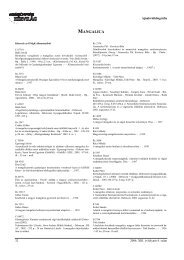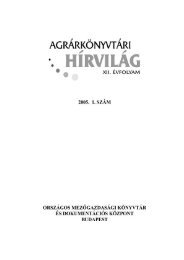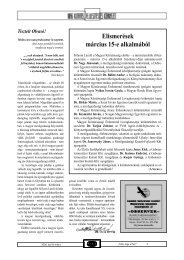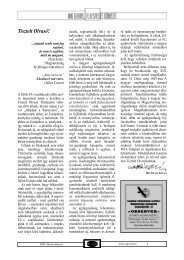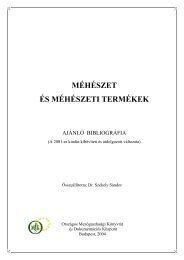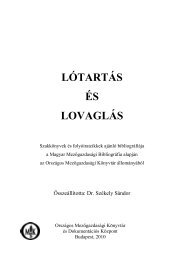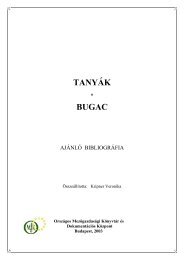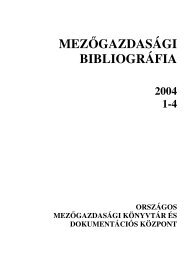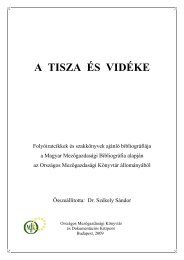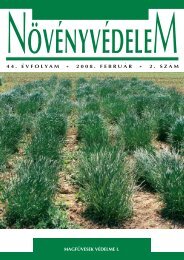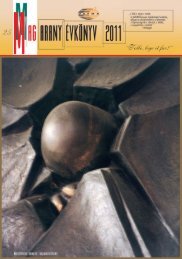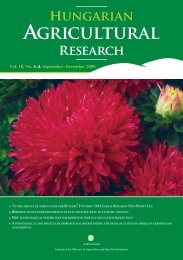2009/9. - Országos MezÅgazdasági Könyvtár
2009/9. - Országos MezÅgazdasági Könyvtár
2009/9. - Országos MezÅgazdasági Könyvtár
You also want an ePaper? Increase the reach of your titles
YUMPU automatically turns print PDFs into web optimized ePapers that Google loves.
490 NÖVÉNYVÉDELEM 45 (9), <strong>2009</strong><br />
SPREAD OF HARLEQUIN LADYBIRD (HARMONIA AXYRIDIS PALLAS,1773)<br />
(COLEOPTERA, COCCINELLIDAE) IN HUNGARY, AND THE FIRST RECORDS FROM<br />
ROMANIA AND UKRAINE<br />
V. Markó 1 and G. Pozsgai 2<br />
1 Corvinus University of Budapest, Department of Entomology, H-1118 Budapest, Ménesi str. 44.<br />
E-mail: viktor.markó@uni-corvinus.hu<br />
2 The Macaulay Institute, Craigiebuckler, Aberdeen AB15 8QH, Great Britain<br />
E-mail: g.pozsgai@macaulay.ac.uk<br />
The Harlequin Ladybird (HL) has been introduced from its natural range to North America and<br />
Europe as a biological control agent. Shortly after its establishment it became one of the most<br />
abundant predatory insects and took a significant part in the control of various invertebrate pests.<br />
However, its spread is a serious threat to many native invertebrate species, mainly coccinellids. The<br />
introduction of the HL has now become one of the best known examples of mistaken use of a nonnative<br />
species as a biological control agent.<br />
In this study the fast invasion of the HL across Hungary has been monitored. We also report the<br />
first records of Harmonia axyridis from Romania and Ukraine. The number of developing<br />
generations and proportion of colour forms in Hungary were investigated. Records on habitat<br />
preference and prey species are also presented.<br />
The HL was recorded in Hungary at the first time in February 2008 (Merkl, 2008) and until 15 st<br />
July 2008 only two specimens were collected. However, HL was then recorded from 103 10×10 km<br />
UTM squares by July <strong>2009</strong>, representing almost all major geographical regions of Hungary. Within<br />
one year, HL became one of the most common ladybird species in Hungary. Mapping of the<br />
distribution of HL showed that it invaded Hungary from western and possibly northern directions.<br />
Harmonia axyridis was collected in Romania (Oradea, UTM: ET61, 10.04.<strong>2009</strong>.; Gurani, UTM:<br />
FS16, 02.08.<strong>2009</strong>.), Ukraine (Berehove, UTM: FU24 and Csop, UTM: EU96, 05.06.<strong>2009</strong>), Slovakia<br />
(Ratka, UTM: DU14, 20.05.<strong>2009</strong>) and Serbia (Subotica, UTM: CS90, 10.06.<strong>2009</strong>.).<br />
Collected adults and reared pupae (n=550) were categorised into colour forms. The frequency of<br />
forma succinea was 91.3% followed by, forma spectabilis (5.3%) and forma conspicua (3.4%).<br />
Taking into account the sum of effective temperature available at two locations in Hungary, time<br />
needed for the newly hatched adults to breed and our rearing results we concluded that 2–4, but<br />
usually three generations of HL can develop in Hungary and that the generations can overlap.<br />
The prey availability was low in summer <strong>2009</strong> and the mass immigration of newly emerged<br />
Coccinella septempunctata adults from herbs into canopy of shrubs and trees resulted in further<br />
reduction in prey of the second HL generations. Among the reared pupae in Budapest (n=65) and<br />
Esztergom (n=125) no parasitisation was found. Only one predator species, a Steatoda sp. spider<br />
(Araneae, Theridiidae) was observed preying on a HL adult.<br />
The HL was found in high density on the following shrubs/trees and prey species: apple (Malus<br />
× domestica): Aphis pomi, Dysaphis plantaginea (Hemiptera, Aphididae); spiraea (Spirea<br />
vanhouttei): Aphis spiraecola, Aphis spiraephaga (Hemiptera, Aphididae); silk tree (Albizia<br />
julibrissin): Acizzia jamatonica (Hemiptera Psyllidae); common walnut (Juglans regia): Callaphis<br />
juglandis (Hemiptera, Aphididae), sweet mock-orange (Philadelphus coronarius): Aphis fabae<br />
(Hemiptera, Aphididae); rose species (Rosa spp.): Macrosyphon rosae (Hemiptera, Aphididae) and<br />
small-leaved lime (Tilia cordata): Eucallipterus tiliae (Hemiptera, Aphididae). HL was also often<br />
collected on elder (Sambucus nigra): Aphis sambuci (Hemiptera, Aphididae) and pear (Pyrus<br />
communis): Cacopsylla pyri (Hemiptera Psyllidae).<br />
Érkezett: <strong>2009</strong>. július 17.



